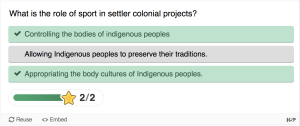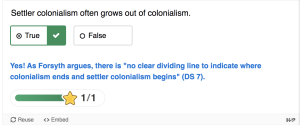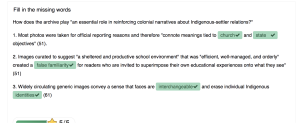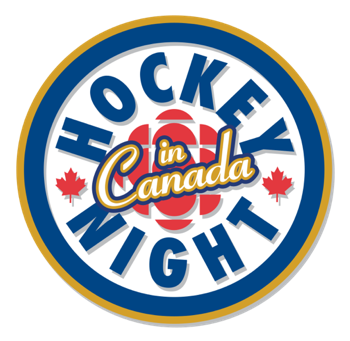4
These are difficult stories. We bear witness in this chapter to the role of sport in furthering the settler colonial projects throughout Turtle Island. Here are some supports to access in the community and from a distance:
First Peoples House of Learning Cultural Support & Counselling
Niijkiwendidaa Anishnaabekwag Services Circle (Counselling & Healing Services for Indigenous Women & their Families) – 1-800-663-2696
Nogojiwanong Friendship Centre (705) 775-0387
Peterborough Community Counselling Resource Centre: (705) 742-4258
Hope for Wellness – Indigenous help line (online chat also available) – 1-855-242-3310
LGBT Youthline: askus@youthline.ca or text (647)694-4275
National Indian Residential School Crisis Line – 1-866-925-4419
Talk4Healing (a culturally-grounded helpline for Indigenous women):1-855-5544-HEAL
Section One: History
A) The Residential School System
Exercise 1: Notebook Prompt
We are asked to honour these stories with open hearts and open minds.
Which part of the chapter stood out to you? What were your feelings as you read it? (50 words)
| Over the period of time that is the era of pre and post European arrival, along with this arrival was the arrival of Christianity. Under this religion, far separate from their own, colonizers changed the fabric of being for the Indigenous people of Canada, through assimilationist practices of separating families, their land, and by teaching stolen youth the white man’s way. Innovation in Canada under colonizer rule wiped out the capacity for self-determination for Indigenous populations. Reading this document instills an intensive response due to the nature in which it is spoken. It is always surprising to read a perspective of such a figure of that time, a person in which keeps another, and hear them speak about the Indigenous youth of Canada. It is spoken with not only, obvious disregard, but the fundamental lack of understanding of the superiority imposed with every action. These conversations reveal how the “school principals used the bands to generate a positive image for the schools,” as an objective being to “spread of brass bands to residential schools was part of a broader expansion of brass music that was associated with social and moral reform.” However, as I read the transcripts, what I was most surprised about was how much the teachers in the residential schools replaced Indigenous music with their own instruments and sound, and then seemed to turn around and detest it, once the kids were well-practised and more importantly, claiming it for their own. As the music, in a twisted way brought “more sympathy… for them, and for the work which we are striving to do”, said the principals, speaking on indigenous student as a sort of project. It was found that the initiative did good, it was undermined. Furthermore, “in some cases, the principals’ enthusiasm for the bands was tempered with their overall low opinion of Aboriginal students,” which is interesting to note as it shows the deep-rooted objective of the principals to crush Aboriginal students’ success wherever found, finding it threatening. I interpret that it is bewildering to them for Indigenous students to succeed, even though it was the teachings of their own doing.
The Final Report of the Truth and Reconciliation Commission of Canada (Volume One).15. Recreation and Sports: 1867-1939 6
|
B) Keywords
Exercise 2: Notebook Prompt
Briefly define (point form is fine) one of the keywords in the padlet (may be one that you added yourself).
| The natural instinct to oppose the attitudes of those perceived in an area.
An international obsession. An allure, without consideration, of the unknown, and of greed and glory in the findings. Intimidation of one in their own land. Demand of control over another’s affairs. Done through relentless policy of assimilation, separation, glorification, and denial. Politically, socially, and culturally shifts the landscape and communities of another’s population.
|
C) Settler Colonialism
Exercise 3: Complete the Activities



Exercise 4: Notebook Prompt
Although we have discussed in this module how the colonial project sought to suppress Indigenous cultures, it is important to note that it also appropriates and adapts Indigenous cultures and “body movement practices” (75) as part of a larger endeavour to “make settlers Indigenous” (75).
What does this look like? (write 2 or 3 sentences)
| Colonizers use sport as a slower, more-involved yet dominant way of colonizing Indigenous peoples of Canada, appropriating their bodies into participating in training and events for colonizer purposes. This purpose includes helping to claim their nationalism on indigenous bodies through sport events as a way to compare their work as settlers. Settler colonialism is happening through sport when the settlers push their perceived importance of sport, firstly on Indigenous youth, and train through colonial schools, to eventually compare performance of Indigenous bodies against others, not only using their bodies for entertainment, but as a test to see which colonizers are using best assimilation practices.
|
D) The Colonial Archive
Exercise 5: Complete the Activities

Section Two: Reconciliation
A) Reconciliation?
Exercise 6: Activity and Notebook Prompt
Visit the story called “The Skate” for an in-depth exploration of sport in the residential school system. At the bottom of the page you will see four questions to which you may respond by tweet, facebook message, or email:
How much freedom did you have to play as a child?
What values do we learn from different sports and games?
When residential staff took photos, what impression did they try to create?
Answer one of these questions (drawing on what you have learned in section one of this module or prior reading) and record it in your Notebook.
| What values do we learn from different sports and games?
From sports and games, mainly from my neck of the woods, I would say the main values learned is how to work with others. In my school, I grew up to be competitive in my love for sports and the game of it all, however, I cannot and will not ever be able to relate to needing sport as a sense of survival or would win out fear of retribution in loss, as mentioned in ‘The Skate’. The values I learned were rooted in choice that you could be competitive if you wanted to be, but there was no force to be. Instead, sport values focused on team-building, personal affirmation, genuine fun in teamwork and the genuine fun in getting better at something. For myself, sports were not a particularly heavy or stressful endeavour, as many only participated if they truly wanted to be there.
|
B) Redefining Sport
B) Sport as Medicine
Exercise 7: Notebook Prompt
Make note of the many ways sport is considered medicine by the people interviewed in this video.
| Aidan Baker displays gratitude in having lacrosse, not just as an outlet but as a dream. He dreams of playing at a higher level, with sport being connected to him for life to get over hardships. Sport is medicine in the way that it is a guide with him, as he describes that the “Game is the cross.” He goes on to explain how sport is healing because it connects him with his family, namely his grandfather, and to the language and culture that was stripped away from them. He finds strength in sport through this culture getting reclaimed, noting the competitive advantage of speaking one’s own language in sport as opponents cannot understand cues.
Dr. Chief Robert Joseph explains how the pain of the past “is with you forever” however this is why sport is so important, as they often were the “most happy moments in school…instructing each other on next moves”, etc. He explains how sport is so healing that it is now crucial to the Indigenous culture, describing it as “essential for wellbeing of Indigenous people everywhere.”
Lastly, Tayan Traadwell, describes sport as medicine in the way in which “sports is central to some of the elements that keep these young people together as they progressed.” What she means is as she went through school, she had help with fees through scholarships, and sports helped her cope with the stress of school and the stress of being an Indigenous student and colonialism that comes with everyday life. She describes how sport helped her have that release, and bring Indigenous students together through sport to be comfortable with each other in a school setting, which is a very empowering thing.
|
C) Sport For development
Exercise 7: Notebook Prompt
What does Waneek Horn-Miller mean when she says that the government is “trying but still approaching Indigenous sport development in a very colonial way”?
| Waneek Horn-Miller specifically talks about lack of access. She reflects on how, when talking about being an Olympian to schools, she is looking around and seeing how wrong it is that there is no system in place for these students to achieve, even in a small way, what she is describing. She describes that in regards to experiencing all the racism she has in her life, she cannot believe the ongoing process of it by the colonial practice of there not being access to sport to give Indigenous youth the same opportunities as everyone else. The government are approaching Indigenous sport development in way that is failing to work with Indigenous institutions to actually develop Indigenous sport.
|
Exercise 8: Padlet Prompt
Add an image or brief comment reflecting some of “binding cultural symbols that constitute Canadian hockey discourse in Canada.” Record your responses in your Notebook as well.

Image from Wikipedia.
The first symbol that comes to mind when talking about hockey is the Hockey Night in Canada symbol. As a young Canadian girl, so many memories of mine involve watching hockey with my dad, and I still wear the hockey night in Canada shirt of his, in Ottawa where I work as a server, on Saturday nights. In this symbol is the CBC symbol as well, which has been a unifying force in Canada, delivering news of the country from all corners, furthering the discussion on Canadian heritage and culture. I think of this symbol and I feel the unifying force of hockey, and how all Canadians have gathered together in one form of another, to watch hockey on Saturday, as the Canadian teams dominate and the number of Canadian players holds the majority in the NHL. This is a show of Canadian culture and it stretches to Indigenous culture that holds their own league with an impressive amount of attendance and spirit themselves. Hockey Night in Canada can definitely have its own agenda, but the discourse surrounding it, is that the program is a unifying force.
|
Section Three: Decolonization
Please see the major assignment for this half of the term in the final section of this chapter.

